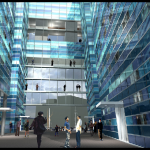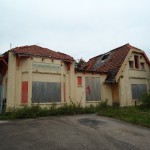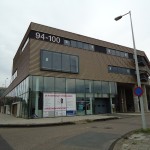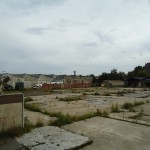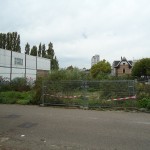On its website the Gemeente Amsterdam proudly announces that, despite the recession, a large turnout of investors interested in the Zeeburgerpad/Cruquiusweg area appeared on their event in May, conveniently forgetting hereby that several citizen organisations have been in a fierce battle with the Gemeente about the development plans of the area for years.
In their own documents of May 2011 the Gemeente says that the new approach for the area is one of “letting the market lead, and the Gemeente follow”. In other words – all might to the moneymakers.
The precise plan that is proposed is that of a luxury marina for boats 9-meters and longer. Given the number of smaller boats currently moored in these waters, this plan definitely does not sound like it is going to include the current inhabitants of the area. The “crowning point“ of the propositioned marina is supposed to become the so-called “Kopgebouw” – a building apparently so named because its upper floors are planned to strangely curve outwards in a frightful stab at ultramodern architecture.
It should house a five-star hotel, offices, a café, conference rooms and fitness clubs as well as offices and a car park. At present, in the immediate vicinity of proposed location of the “Kopgebouw”, at the round-about at the end of Th. K. van Lohuizenlaan, several rows of
historically valuable warehouses converted into living spaces are located. The disparity between present and future is pretty near shocking. Internet reactions of local residents vary in calling the plans for the “Kopgebouw” something on a scale between “pretentious” and “megalomaniac”. Looking up the computer animated model of the future building on the website http://www.kopgebouw.nl this is indeed the reaction which may impress itself on you, especially because of the enormous, almost grotesque contrast in style between the highly-modern sterility of the commercial ‘Kopgebouw’ and the thriving, densely populated living area surrounding its proposed location.
Now, the ludicrous aspect of this affair is that, if we believe a member of the SP Zeeburg, the actual development plan for the area dates to 1943, and has not been significantly changed or even amended since. By the law urban development plans have to be revised every ten years. If the official area development plan was overhauled according to all rules of the law, this would take years and the cost would be considerable. Most of all, court cases opened in complaint by local citizen organizations would have to be taken into account.
The neighbourhood organization Red Het Blauw states that the reason given for not revising the current proposal is that going through the motions of officially changing the area development plans would suck too much money out of the city’s treasury. As if persisting with the project of a luxury marina did not involve substantial expenditures which would consequently have to be born by tax payers.
Citizen organizations have much to criticize about the way the Gemeente charges forward with their blinkers on. Most of all Red Het Blauw, an organization that was opened for the very purpose of showing force against the marina project, and which has called the city’s course of action “disrespectful” and “irresponsible”.
The way these organizations see it is that the Gemeente wants to replace an organic, culturally and historically rich neighbourhood with buildings prestigious and financially profitable for Amsterdam, but without any cultural or historical value. They see this as urban planning at its worst. Why should precedence be given to anonymous hotel guests and high class office workers over the multicultural long-term inhabitants of the area? Why transform this perfectly viable neighbourhood into another anti-septic playground of the business world as other parts of Amsterdam already have been?
And let’s remark that it is doubtful that many people are really going to jump at the new opportunities: In 2009 there was a whole song and dance made about the opening of a new, multifunctional office building, optimistically named ‘De Nieuwe Vaart‘, just two addresses down on the Cruquiusweg. More than two years later the large glass windows of the huge building sport nothing than anti-squat posters. On its website the owner’s desperation transpires as he announces it to be “immediately [...] both for rent or for sale”.
Speculators such as Amvest or Woensbergen BV have been busy in the area for years, buying up assets, leaving the premises empty, “piling them up”, so to speak, for eventual huge profits. At a future date, should the marina project be set up in earnest, the burden of constructing new local infrastructures will be carried by the tax payers of the Gemeente of Amsterdam, whereas speculators will cash in big time.
The intentions of these firms become clear when looking to the nearby Dapper and Czaar Peter neighbourhoods where this very dreaded scenario has already taken place, albeit on an indeed less farcical scale than what is planned for the Zeeburgerpad/Cruquiusweg area: After all sorts of intermediary trade and transactions, the original residents of the neighbourhoods, social renters, have well-nigh all been driven away, so the money-grubbers could sell the former social housing estates to “more prosperous” layers of society. A prime example of the wide-spread, ugly process of gentrification.
As already said, neighbourhood organizations such as Red Het Blauw, or Vereniging Zeeburgs Boten Overleg, have been in judicial struggle with the Gemeente about the development plan for years; the Gemeente on its side has refused any citizen-inclusive modus operandi for as long. The last momentous thing that happened in the area was, in 2009, the demolition of a one hundred years old pier and a hundred years old customs warehouses, formerly situated on the Zeeburgerkade and the Cruquiusweg. A citizen’s committee had handed in a demand to put the buildings, which they felt added to the area’s character, on the National Heritage List as early as 2006, but this was declined in view of the Gemeente’s plans for the area. The appeal for this court-case was still running when the Gemeente moved in brandishing their thus illegally acquired demolition permit. Furthermore, the buildings were demolished in a doubly illegal manner, sparrows and bats having housed in some of the most dilapidated buildings, both of which species are protected under the Dutch Flora- and Fauna Law.
In the period immediately preceding the destruction of the buildings, citizens, many of them from the immediate neighbourhood, organized themselves to campaign on a judicial level as well as by direct action, such as occupation of the buildings and terrains in question. The battle drew out for weeks but was ultimately lost. A group of squatters helped with a solidarity action, wanting to help instigate the democratic dialogue between citizens and municipality which the latter always neglected. In this the squatters were supported by more than ten associations, among which the Zeeburg branch of the Socialist Party, the Green Party as well as organizations expert in protection of architectural patrimony such as the Cuypersgenootschap and the Atelier van Bouwmeesters. To date the former location of the warehouses are still empty lots.
Other squats in the neighbourhood included, in 2005, Zeeburgerpad 54, an erstwhile bakery. It was evicted for demolition and the building’s former site has now been a wasteland for years. In 2006, Cruquiusweg 79 was squatted and subsequently evicted in order to be left unoccupied again. It was then re-squatted, again evicted, with once more only emptiness to follow. In April 2011 a group of people squatted Zeeburgerpad 13-14, property of a speculator with much capital in the form of abandoned buildings in the area. The house in question was evicted around three months later.
Now they want to add the Cruquiusweg 86 to the list of desolation. As we have written elsewhere, ‘the amount of empty square meters [on the Cruquiusweg] is impressive’: The area is artificially stifled by the arrogant, avaricious and near-autistic policies of the Gemeente Amsterdam, who over the past few years have systematically refused Public Participation in this matter, forcing through their unreasonable and ultimately devastating plans ignoring one of the tenets legally integrated into the Dutch system of democracy.
In view of the context of a neighbourhood fighting for years, and whose situation itself is part of a city-wide class struggle of the gradually marginalized lower class inhabitants of characteristic neighbourhoods, expelled to make space for the illustrious and lucrative, the living group of the Cruquiusweg 86 is not ready to abandon a neighbourhood which they appreciate a lot.

